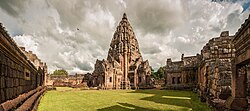The province is subdivided into 23 districts (amphoe). The districts are further subdivided into 189 subdistricts (tambon) and 2212 villages (muban).
|
|
Buri Ram (Thai: บุรีรัมย์) is one of the north-eastern provinces (changwat) of Thailand. Neighboring provinces are (from south clockwise) Sa Kaeo, Nakhon Ratchasima, Khon Kaen, Maha Sarakham and Surin. To the south-east it borders Oddar Meancheay of Cambodia. The name Buri Ram means City of happiness.

The province is subdivided into 23 districts (amphoe). The districts are further subdivided into 189 subdistricts (tambon) and 2212 villages (muban).
|
|

